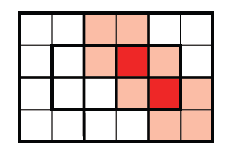| ENG RUS | Timus Online Judge |
Open Ural FU Personal Contest 2013
Contest is over
H. Glass PyramidTime limit: 1.0 second Memory limit: 64 MB  Vova is a skyscraper fan. When he arrives in a city that has any
skyscrapers, he always tries to get to the observation deck in the highest
skyscraper to make several shots from there. This time is no exception. As
soon as Vova arrived in Hong Kong, right after checking in a hotel, he got to
the International Commercial Center, a 118-floor building that was built a
couple of years ago. Before the main entrance into the International Commercial Center there is
a pyramid of large glass blocks. Each block has the shape of a one meter
height rectangular parallelepiped with a 2 × 2 meter square base.
The pyramid's lowest layer is m × n meter large. The second layer
is When Vova got to the observation platform, located at the skyscraper's
100-th floor, he saw the pyramid from there as a rectangular field, divided
into 1 × 1 meter cells. The reddish hue of each cell hinted the
number of reddish glass blocks that laid on this cell. Vova took the photo
of the pyramid from above and now he wants you to take a look at this
photo and find out which pyramid blocks are made of reddish glass and
which ones are made of colorless glass. Vova also says that there is no
reddish block lying exactly above a colorless block. InputThe first line contains integers m and n that are sizes of the
pyramid's base (2 ≤ m, n ≤ 40; m and n are even). Then
m lines follow, each of them contains n non-negative integers, describing the photo
Vova took. Each integer shows the number of reddish blocks lying above the
corresponding cell. It is guaranteed that the input gives some possible
arrangement of blocks in the pyramid. OutputPrint the description of the layers, from the lowest one to the highest
one. To print information about the i-th layer, use ki lines each
containing li characters (k1 = m/2; l1 = n/2; Sample
Problem Source: Open Ural FU Personal Contest 2013 |
